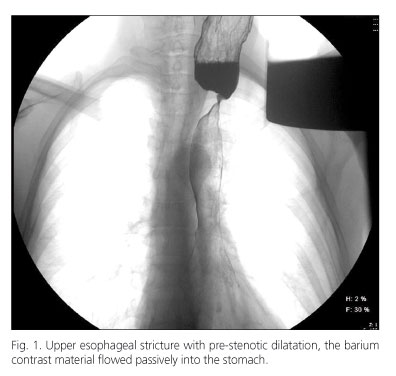Mi SciELO
Servicios Personalizados
Revista
Articulo
Indicadores
-
 Citado por SciELO
Citado por SciELO -
 Accesos
Accesos
Links relacionados
-
 Citado por Google
Citado por Google -
 Similares en
SciELO
Similares en
SciELO -
 Similares en Google
Similares en Google
Compartir
Revista Española de Enfermedades Digestivas
versión impresa ISSN 1130-0108
Rev. esp. enferm. dig. vol.104 no.3 Madrid mar. 2012
https://dx.doi.org/10.4321/S1130-01082012000300013
LETTERS TO THE EDITOR
Unusual technique for caustic esophagitis
Una técnica poco usual para la esofagitis cáustica
Key words: Subcutaneous esophagoplasty. Caustic stenosis. Dysphagia.
Palabras clave: Esofagoplastia subcutánea. Estenosis caústica. Disfagia.
Dear Editor,
We present this case because of its rarity, as we have not found anything similar in young non-neoplastic patients. We describe the case of a 36 years-old woman with long-term dysphagia for solids. Her past medical history reveals an esophagoplasty with subcutaneous colon interposition, which was performed in Romania 15 years before, due to caustic stricture. Stenosis of the cologastric anastomosis, after an occlusive episode, required reintervention in 2008. Currently she only tolerates pureed food. Physical examination showed a scar on the left side of her neck, which extended through the chest and abdomen (a large median laparotomy scar).
An esophago-gastroduodenal series was done (Fig. 1), which displayed: "Upper esophageal stricture with pre-stenotic dilatation; the barium contrast material flowed passively into the stomach". Subsequently, CT scans of the cervical, thoracic and abdominal areas were performed using i.v. contrast with the following results (Fig. 2): "cologastric anastomosis consisting of colon subcutaneous transposition and reentry to abdominal cavity to reach the gastric body". A gastroscopy demonstrated a recessed area 24 cm below the dental arch, with remaining food debris and a concavity to the left which was not accessible. The patient was not dilated because of lack of wall thickness and perforation risk. Currently awaiting surgery.
Discussion
Some affections, like tumors or those caused by the ingestion of caustic substances, can lead to severe esophageal damage and require wide resection. To restore the transit, we must repair the solution of continuity using several surgical procedures, such as colon or small intestine interposition, gastric pull-up or colon patch esophagoplasty (1). Nowadays, the most used surgical technique is the esophagocoloplasty or pharingocoloplasty, consisting of the transposition of a colonic segment into a retrosternal position or into posterior mediastinum (2).
We present a case in which the esophagoplasty was subcutaneous. Proximal esophagus was incorporated into the presternal space and anastomosed with the tubular structure that replaces the esophagus (in this case, the colon) (3). There are few references in the literature (4,5) to this technique because it has fallen into disuse. The anterosternal subcutaneous way has just been used in those cases in which a long graft for esophageal replacement was required, having previously rejected intrathoracic anastomosis (6). Its major complications include necrosis of the grafted segment and anastomotic leakage.
Aida Selfa-Muñoz1, Rosario del Pilar López-Segura1, Francisco Javier Casado-Caballero1,
Manuel López-Cantarero-Ballesteros2 and Francisco Javier Salmerón-Escobar1
1Clínic Unit of Gastroenterology. 2Department of General Surgery. Hospital San Cecilio. Granada, Spain
References
1. Kim SH, Lee KS, Shim YM, Kim K, Yang PS, Kim TS. Esophageal resection: indications, techniques, and radiologic assessment. Radiographics 2001;21(5):1119-37. [ Links ]
2. Mardini S, Salgado CJ, Kim Evans KF, Chen HC. Reconstruction of the esophagus and voice. Plast Reconstr Surg 2010;126:471-85. [ Links ]
3. García A, Rodríguez I, Roque F, et al. Gastroesofagoplastia subcutánea isoperistáltica. Rev Cubana Cir 1976;15:679-99. [ Links ]
4. García A, Morandeira A. Posibilidades de las sustituciones esofágicas. Rev Cubana Cir 1987;24:125-51. [ Links ]
5. Jain V, Rodrigues GS, Gupta K. Ischaemic necrosis of subcutaneous colonic neoesophagus: an unusual complication of presternal hypertrophic scar. Singapore Med J 2006;47:235-6. [ Links ]
6. Yannopoulos PA. Subcutaneous transposition of the proximal oeso-phagus in oesophagoplasty. Thorax 1985;40:936-9. [ Links ]











 texto en
texto en 



